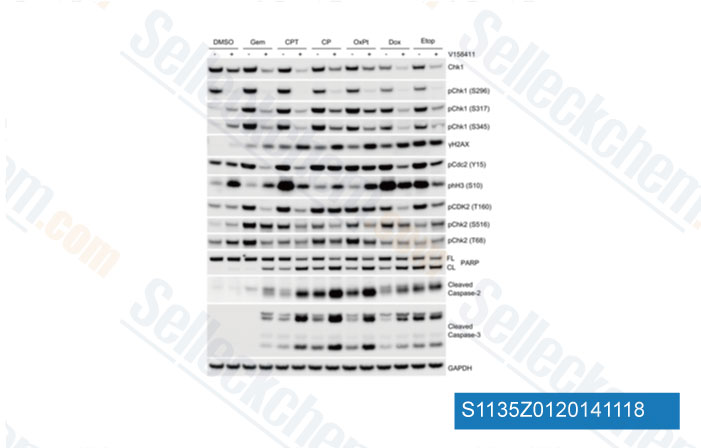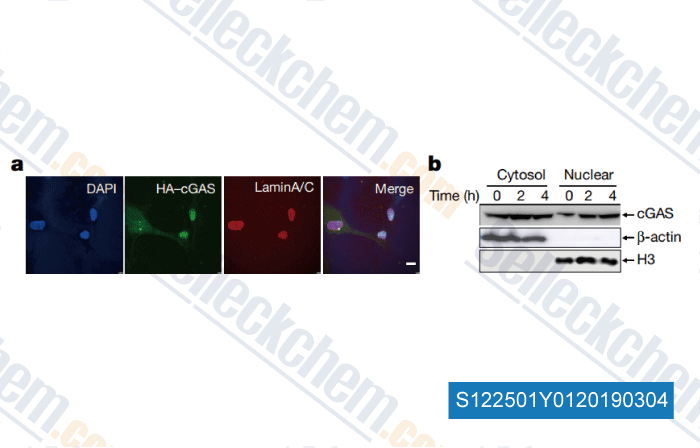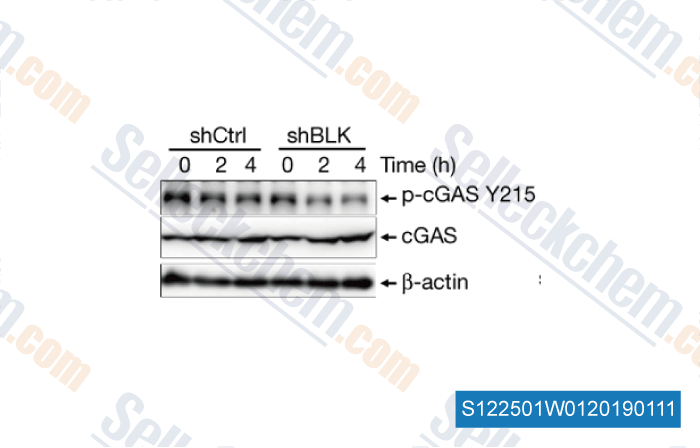|
Toll Free: (877) 796-6397 -- USA and Canada only -- |
Fax: +1-832-582-8590 Orders: +1-832-582-8158 |
Tech Support: +1-832-582-8158 Ext:3 Please provide your Order Number in the email. |
Technical Data
| Formula | C29H32O13 |
|||
| Molecular Weight | 588.56 | CAS No. | 33419-42-0 | |
| Solubility (25°C)* | In vitro | DMSO | 100 mg/mL (169.9 mM) | |
| Water | Insoluble | |||
| Ethanol | Insoluble | |||
|
* <1 mg/ml means slightly soluble or insoluble. * Please note that Selleck tests the solubility of all compounds in-house, and the actual solubility may differ slightly from published values. This is normal and is due to slight batch-to-batch variations. * Room temperature shipping (Stability testing shows this product can be shipped without any cooling measures.) |
||||
Preparing Stock Solutions
Biological Activity
| Description | Etoposide is a semisynthetic derivative of podophyllotoxin, which inhibits DNA synthesis via topoisomerase II inhibition activity which enhances double-strand and single-strand cleavage of DNA and reversibly inhibits repair by topoisomerase II binding. Etoposide induces autophagy, mitophagy and apoptosis. | |
|---|---|---|
| Targets |
|
|
| In vitro | Etoposide inhibits DNA synthesis by forming a complex with topoisomerase II and DNA, which induces breaks in double stranded DNA and prevents repair by topoisomerase II binding. Accumulated breaks in DNA prevent entry into the mitotic phase of cell division, and lead to cell death. Etoposide acts primarily in the G2 and S phases of the cell cycle. [1] Etoposide inhibits the growth of murine angiosarcoma cell line (ISOS-1) in a 5 days-period with IC50 of 0.25 μg/mL. Cell growth of normal murine microvascular endothelial cells (mECs) is less sensitive to Etoposide with IC50 of 10 μg/mL). [2] Etoposide treated for 6 hr inhibits colonies of tetraploid variant of the human leukemic lymphoblast line CCRF-CEM with IC50 of 0.6 μM. [3] Etoposide treated for 2 hr inhibits growth of human pancreatic cancer cell line Y1, Y3, Y5, Y19, YM. YS, and YT with IC50s of 300 μg/mL, 300 μg/mL, 300 μg/mL, 91 μg/mL, 0.68 μg/mL, 300 μg/mL, 300 μg/mL, and 260 μg/mL, respectively. [4] Etoposide exposed for 1 hr inhibits growth of human glioma cell lines CL5, G142, G152, G111, and G5 with IC50 of 8, 9, 9.8, 10, and 15.8 μg/mL respectively for 12 days. Under same condition, the IC90 value is attained in cell lines CL5, G152, G142, and G111 at 26, 27, 32, and 33 μg/mL. Etoposide inhibition of topoisomerase II is homogeneous for each cell. The average inhibition rates are 15%, 21.8%, 31.8%, 41.5%, and 49.5% for 1, 2, 4, 8, and 16 μg Etoposide, respectively. [5] |
|
| In vivo | Etoposide administrated as a single agent is found to been ineffective in many xenografts growth, such as Heterotransplanted Hepatoblastoma NMHB1, and NMHB 2, [6] human neuroblastoma xenograft, [7] and human gastrointestinal cancer xenograft, [8] while the dose of 10 mg/kg i.p. Etoposide inhibits murine angiosarcoma cell ISOS-1 tumors in 36% of controls. [2] Etoposide induces tumor immunity in Lewis lung cancer. A single administration of 50 mg/kg Etoposide i.p., induces a 60% survival of C57B1/6 mice injected with Lewis lung cancer cell (3LL) over 60 days. About 40% of these surviving mice reject a subsequent challenge with 3LL, while none of control mice survive beyond 30 days. 3LL cells which have survived an 90% lethal concentration of Etoposide in vitro kill 75% of recipient mice, but 60% surviving mice reject challenge with 3LL. Splenocytes harvested from tumor rejecting mice protect naive mice injected with 3LL. [9] |
Protocol (from reference)
| Kinase Assay: |
|
|---|---|
| Cell Assay: |
|
| Animal Study: |
|
References
Customer Product Validation

-
Data from [Data independently produced by BMC Cancer, 2014, 14, 483]

-
Data from [Data independently produced by , , Leukemia, 2015, 29: 1702–1712]

-
Data from [Data independently produced by , , Nature, 2018, 563(7729):131-136]

-
Data from [Data independently produced by , , Nature, 2018, 563(7729):131-136]
Selleck's Etoposide has been cited by 357 publications
| Construction of human pluripotent stem cell-derived testicular organoids and their use as humanized testis models for evaluating the effects of semaglutide [ Theranostics, 2025, 15(6):2597-2623] | PubMed: 39990223 |
| ROR1 CAR-T cells and ferroptosis inducers orchestrate tumor ferroptosis via PC-PUFA2 [ Biomark Res, 2025, 13(1):17] | PubMed: 39849645 |
| Systematic Comparison of FBS and Medium Variation Effect on Key Cellular Processes Using Morphological Profiling [ Cells, 2025, 14(5)336] | PubMed: 40072065 |
| Bafilomycin A1 induces colon cancer cell death through impairment of the endolysosome system dependent on iron [ Sci Rep, 2025, 15(1):5148] | PubMed: 39934167 |
| Coordinated inheritance of extrachromosomal DNAs in cancer cells [ Nature, 2024, 635(8037):201-209] | PubMed: 39506152 |
| BRD-810 is a highly selective MCL1 inhibitor with optimized in vivo clearance and robust efficacy in solid and hematological tumor models [ Nat Cancer, 2024, 10.1038/s43018-024-00814-0] | PubMed: 39179926 |
| Gene body DNA hydroxymethylation restricts the magnitude of transcriptional changes during aging [ Nat Commun, 2024, 15(1):6357] | PubMed: 39069555 |
| Uncoupling of mTORC1 from E2F activity maintains DNA damage and senescence [ Nat Commun, 2024, 15(1):9181] | PubMed: 39448567 |
| Senescence suppresses the integrated stress response and activates a stress-remodeled secretory phenotype [ Mol Cell, 2024, 84(22):4454-4469.e7] | PubMed: 39481386 |
| Non-classical action of Ku70 promotes Treg suppressive function through a FOXP3-dependent mechanism in lung adenocarcinoma [ J Clin Invest, 2024, e178079] | PubMed: 39446493 |
RETURN POLICY
Selleck Chemical’s Unconditional Return Policy ensures a smooth online shopping experience for our customers. If you are in any way unsatisfied with your purchase, you may return any item(s) within 7 days of receiving it. In the event of product quality issues, either protocol related or product related problems, you may return any item(s) within 365 days from the original purchase date. Please follow the instructions below when returning products.
SHIPPING AND STORAGE
Selleck products are transported at room temperature. If you receive the product at room temperature, please rest assured, the Selleck Quality Inspection Department has conducted experiments to verify that the normal temperature placement of one month will not affect the biological activity of powder products. After collecting, please store the product according to the requirements described in the datasheet. Most Selleck products are stable under the recommended conditions.
NOT FOR HUMAN, VETERINARY DIAGNOSTIC OR THERAPEUTIC USE.
